Caisson for well: purpose of construction, materials,
What does the word caisson mean for water? What can this structure be made of? How much does a caisson cost for a well? Is it difficult to install it yourself?
We will try to answer these questions in the article.
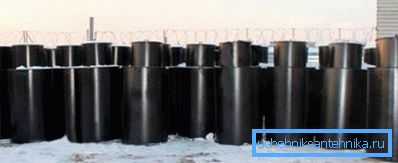
What it is
The caisson per well is a sealed or partially sealed container of factory or handicraft production, which is mounted at the wellhead. Its bottom is buried below the level of freezing, the cover is supplied with a hatch and is insulated to the maximum. Thus, in the context of the caisson looks like a sharp expansion of the trunk before going to the surface.
Why do you need this design?
It solves several technical problems at once.
- Warming When the pump is idle, water stands in the flow pipe without moving. It is clear that in the winter cold it will quickly turn into ice with quite predictable consequences for the equipment. A well with a caisson is not afraid of frost: with proper insulation of the lid, the temperature in a closed space, partially recessed below the freezing level, will always be above zero.
It is useful: for the same reasons, the water supply pipes are usually laid in the ground, below the notorious level of soil freezing.
- The surface layer of the soil - the most loose. Wind and rain erosion, the vital activity of worms and insects, the decay of organic matter make it extremely unstable. At the same time, the casing pipe, willy-nilly, must end below the soil surface: as we remember, it must be brought into the house at a fairly considerable depth. The walls of our design will prevent the shedding and subsidence of soil near the mouth.
- Caissons for the well often serve as an installation site for additional equipment that would otherwise take up space in the house. They can be mounted:
- Check valve It must be installed after the pump and prevents water from discharging from the well system when it stops.
- A coarse filter that protects the water supply system from pollution and damage to shut-off fittings by suspensions. Centrifugal borehole pumps can easily raise with a fair amount of abrasive particles that have passed a coarser filter in the casing.
- The hydroaccumulator, smoothing the peaks of water consumption and allowing the pump to stand idle, saving its resource.
- Automatic pump control.
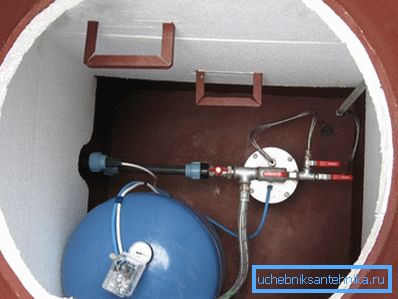
- Finally, in shallow wells drilled on sand (up to the upper aquifer), surface pumps are often used, raising the water due to the vacuum created in the pipe. It is also logical to install such a pump in close proximity to the wellhead: its efficiency will be maximum, and the noise level in the house will be almost zero.
Is it possible to well without a caisson or any of its analogs?
Yes.
But with a few caveats.
- This is possible either with seasonal use, or in warm regions of the country. The water supply pipe is laid on the surface of the soil or with a symbolic depth; as a maximum - it is insulated with an outer shell of polystyrene, polyethylene foam, etc.
- The check valve in this case is installed immediately after the pump, before the fitting-adapter to the water supply pipe. The hydroaccumulator is in the house, since it can be installed anywhere in the water supply system.
Curiously: instead of the accumulator is often used cumulative capacity. To ensure sufficient pressure, it is mounted in the attic of the house. This solution, among other things, allows you to endure long-term power outages without discomfort.
Alternative
A simple alternative to the caisson is a pit, a shallow well with walls reinforced with reinforced concrete monolith or brickwork in place. The pit is constructed quite simply; costs at the same time much less than the purchase of a turnkey solution.
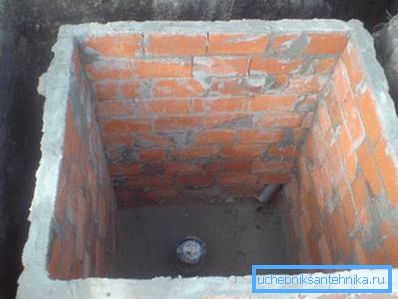
How, in this case, the purchase of a caisson is justified?
- Reducing the time spent on well development.
- The best waterproofing that can be important with a high level of surface groundwater.
Materials and their features
What are caissons for wells made of?
Reinforced concrete
The set of properties of this material, say politely, is ambiguous. On one side of the scale is the highest strength and durability of reinforced concrete.
On the other - a set of features that make its use a rather dubious enterprise:
- High thermal conductivity. Reinforced concrete structure needs additional weatherization.
- Hygroscopicity. Concrete absorbs water; crystallizing inside the structure, it drastically reduces its resource. In addition, the joints between the rings from which the caisson is built are often allowed to flow.
By the way: high-quality waterproofing (asphalt mastic is usually used in this quality) solves this problem.
- Huge weight, which eventually leads to subsidence and deformation of the pipeline, and even to its damage.
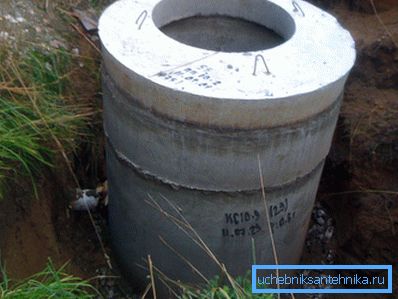
Steel
Steel caisson under the well is much lighter than concrete. This list of advantages ends.
Alas, there are drawbacks too.
- The thermal conductivity of the walls is even higher than in the previous case. Warming required.
- Steel is a material that is resistant to corrosion. Corrosion protection is usually a coating from the inside and outside of the same bitumen mastic; it is quite effective, but easily broken by mechanical stress.

Plastic
In recent years, the caisson for wells is increasingly made of polyethylene or polypropylene. Plastic products are much more in demand than competing solutions, and for good reason.
The list of their merits is indeed impressive.
- Low weight. Installation does not require paying for crane services: two people will easily lift and install the structure.
- Durability. Service life is estimated to be at least 50 years.
- Good thermal insulation quality. Even without additional insulation input in the plastic caisson will not freeze.
- Complete lack of hygroscopicity or corrosion. Staying in the damp does not bring plastic to any harm.
The only material lack is insufficient rigidity. How this problem is solved - we will find out a little later.

Cost of
The cost of the caisson for the well is determined by:
- The material is its type and thickness. So, 3-mm steel costs 20% less than 4-mm.
- Sizes. It is clear that with their increase in price increases.
Most of the products fit in the range of 10 - 20 thousand rubles. At the same time plastic products have the lowest cost; steel in second place; the outsider on this list is reinforced concrete.
Installation
Instructions on the actual installation of the caisson - common to all materials used.
Only the methods of sealing the casing and backfill are different.
- The ditch which size is 10-20 centimeters more than a caisson comes off.
- The design is lowered by the liner on the casing, after which it is cut in place.
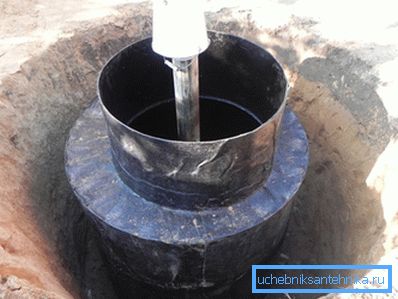
- In the case of reinforced concrete products, the connection with the casing is sealed with a cement mortar with the addition of liquid glass. The connection of a steel caisson with a steel pipe is boiled by a continuous seam; The plastic pipe is connected to the plastic case by means of a special cap with a silicone sealant.
- The water supply pipe and the power cable are discharged through a sleeve in the wall - also, of course, to ensure tightness.
- The pit falls asleep. In the case of steel or reinforced concrete caisson, the previously removed soil is used for backfilling; plastic is filled with sand-cement mixture in a ratio of 5: 1. When moistened, the backfill forms a durable sarcophagus that will protect the walls from deformation and will prevent the structure from being squeezed out.

Conclusion
For more information on what a caisson is for a well and how it can be, the reader will be offered a video in this article. Successes!